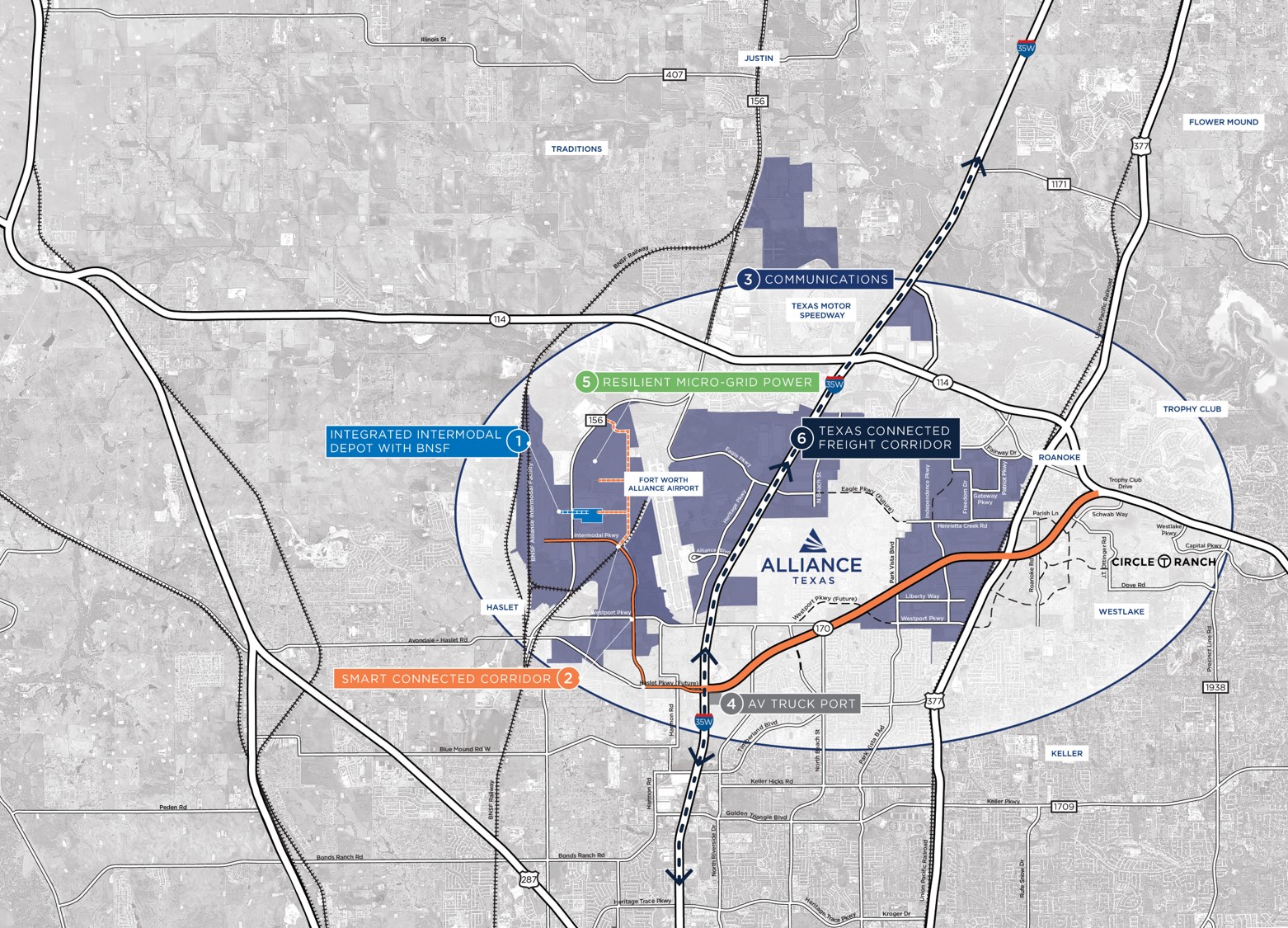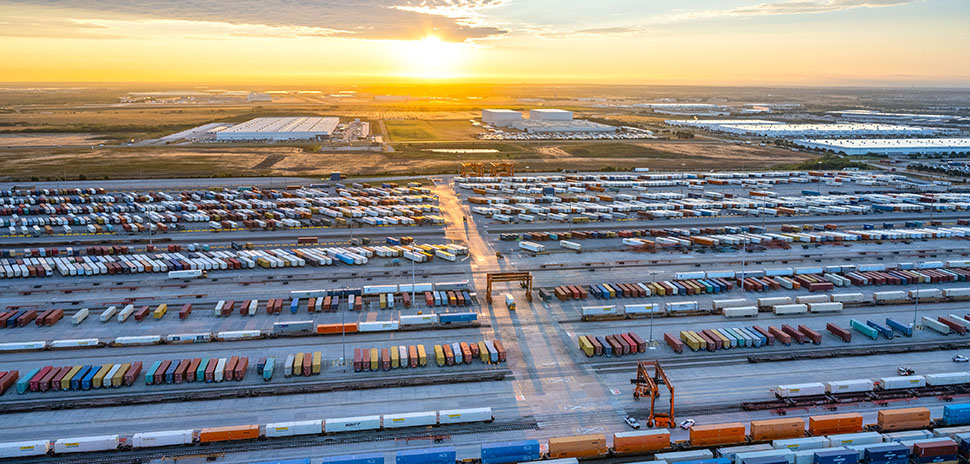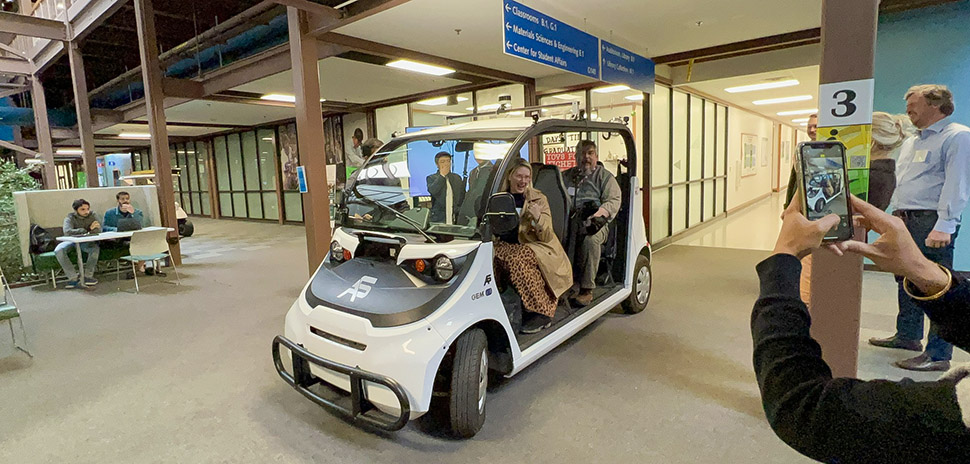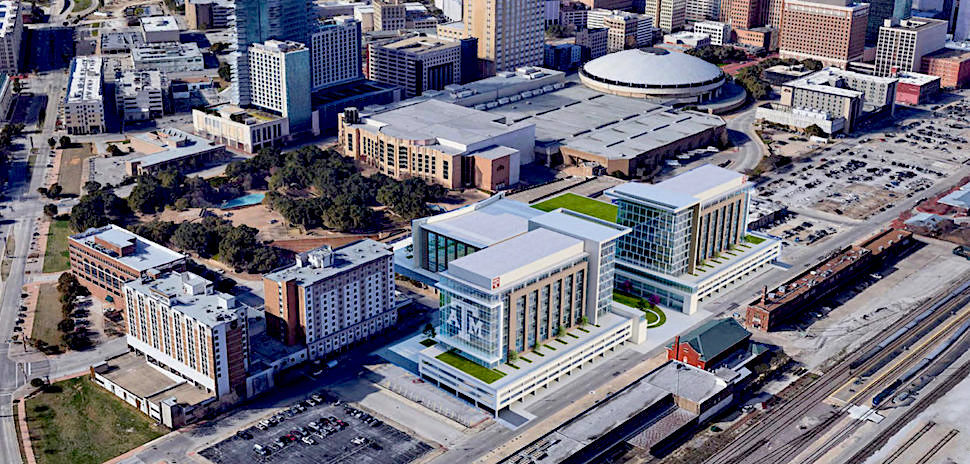Setting a “global benchmark” in port operations
“AllianceTexas is poised to redefine what it means to be a modern logistics hub,” Ross Perot Jr., chairman, The Perot Group and Hillwood, said in a statement. “By integrating automation and forward-looking technologies through this grant, we will not only strengthen the national supply chain but also set a global benchmark for resilience and efficiency in port operations.”
Hillwood said the multi-million-dollar public-private partnership connects the AllianceTexas Inland Port, one of the nation’s critical supply chain hubs, to the Dallas-Fort Worth regional transportation network and its bigger state and national ecosystems, including the Texas Connected Freight Corridor (TCFC) and the critical National Highway Freight Network corridors of Interstate 35 and Interstate 45.
The network will be supported by a direct connector bridge, linking the AllianceTexas Inland Port to State Highway 170.
According to Hillwood, the bridge will help ease east-west freight traffic, diverting trucks from Interstate 35W and nearby suburban roads, thereby improving road safety, air quality, job accessibility, and overall quality of life for more than 3 million residents across Denton and Tarrant Counties.

The AllianceTexas Smart Port map [Source: Hillwood]
Next evolution of the 15th busiest inland port in America
Currently, about 4.2 million trucks move in and out of the BNSF Railway Alliance Intermodal Facility each year, and Hillwood said that number will almost double by 2035.
Ranked as the 15th busiest inland port nationally, Hillwood said AllianceTexas is the southwestern United States’ primary port of entry, connecting goods shipped globally from Los Angeles, Long Beach, and Houston via intermodal rail containers.
AllianceTexas also connects to nearshoring in Mexico and with more than half of all U.S. freight tonnage moving through Texas. It also will play a key role in advancing the Texas Connected Freight Corridors Project, addressing freight safety and mobility needs.
Supporting intermodal growth at AllianceTexas
According to Hillwood, AllianceTexas’ global logistics hub is one of the nation’s largest intermodal hubs, connecting air (Perot Field Fort Worth Alliance Airport), road (I-35/SH-170) and rail (BNSF Intermodal Facility).
Hillwood said the Smart Port project will support the future growth of AllianceTexas’ intermodal services, particularly those directed toward Mexico, and will improve resilience in the supply chain through enhanced freight logistics, optimized freeway lane connections, and integrated technology for efficient freight movement.
In the announcement, TxDOT Executive Director Marc Williams said that the Smart Port will allow the supply chain to function “more efficiently and more reliably” than ever before. In Texas, it means greater safety and reducing congestion on the highway network while connecting to the U.S. ecosystem.
“The project ties into the National Highway System, which includes the 865-mile Texas Connected Freight Corridor and its critical corridors I-35 and I-45,” he said.
Smart Port driven by public-private collaboration
“The award of an $80 million grant to the AllianceTexas Inland Port Project is a groundbreaking achievement made possible by the collaboration of leaders across the public and private sectors,” said Denton County Judge Andy Eads, who also serves on the Regional Transportation Council.
Eads said the project “allows Dallas-Fort Worth to serve as a transformative model for the efficient movement of goods to market.” He credited the success of the project to key partnerships, adding, “I would like to thank Tarrant County Commissioner Gary Fickes, my colleague on the RTC, as well all dedicated leaders of the RTC and the legislative community from across Dallas-Fort Worth, for recognizing the importance of this project to the long-term economic outlook of the region, state, and nation.”
Hillwood said key components of the Smart Port project include:
- A State Highway 170/Intermodal Parkway Smart Connected Bridge, facilitating vehicle-to-infrastructure (V2X) communication and connected/autonomous vehicle (CAV) deployment.
- An integrated Intermodal Depot with BNSF Railway, providing a 32-acre container lot with drayage serviceability between BNSF’s Intermodal hub and 14 million square feet of future next-generation warehouse space.
- Long-term 5G communication network capacity, supporting both semi- and fully autonomous technology capabilities and boosting the public/private 5G network.
- A TruckPort for electric vehicle (EV) freight operations, equipped with EV/hydrogen charging units designed for short- and long-haul operations.
- Independent and renewable energy micro-grid support, providing strategically placed energy storage to manage demand spikes and enhance resilience against energy disruptions.
- Connection to the Texas AV/EV Connected Freight Corridor, creating a seamless platform that elevates inland port connectivity across the 865-mile Texas Triangle (DFW, Austin-San Antonio, and Houston).
TxDOT Executive Director Marc Williams said the Smart Port will allow the supply chain to function “more efficiently and more reliably” than ever before, providing greater safety and reducing congestion on Texas’ highway network.
“The project ties into the National Highway System, which includes the 865-mile Texas Connected Freight Corridor and its critical corridors I-35 and I-45,” he said in a statement.
Smart Port partners
NCTCOG is a voluntary association of local governments established in 1966 to help them plan for common needs, cooperate for mutual benefit, and coordinate for sound regional development. NCTCOG serves a 16-county region of North Central Texas, which is centered on the two urban centers of Dallas and Fort Worth.
The Regional Transportation Council of the North Central Texas Council of Governments has served as the Metropolitan Planning Organization (MPO) for regional transportation planning in the Dallas-Fort Worth area since 1974. It works in cooperation with the region’s transportation providers to address the complex transportation needs of the rapidly growing metropolitan area.
The Dallas-Fort Worth metropolitan area includes Collin, Dallas, Denton, Ellis, Hood, Hunt, Johnson, Kaufman, Parker, Rockwall, Tarrant and Wise counties. The RTC’s 45 members include local elected or appointed officials from the area and representatives from each of the area’s transportation providers.
Consisting of 27,000 acres, the Alliance Texas development is anchored by the world’s first dedicated industrial airport, Perot Field Fort Worth Alliance Airport, and it hosts one of the nation’s leading intermodal hubs.
AllianceTexas is home to 575 companies that have created more than 66,000 direct jobs and have roughly 58 million square feet of developed commercial real estate assets. Hillwood said that Alliance Texas’ cumulative impact since 1989 is an estimated $120 billion for the North Texas region.
![]()
Get on the list.
Dallas Innovates, every day.
Sign up to keep your eye on what’s new and next in Dallas-Fort Worth, every day.

































